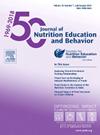Outcomes of Children's Cooking Programs: A Systematic Review of Intervention Studies
IF 2.3
3区 医学
Q2 EDUCATION, SCIENTIFIC DISCIPLINES
引用次数: 0
Abstract
Objective
To examine the factors that make such programs successful, this systematic review compared the outcomes of children's participation in cooking interventions based on intervention characteristics.
Design
Systematic review of randomized controlled trials of children's participation in cooking interventions published between 1998 and 2022 guided by the Preferred Reporting Items for Systematic Reviews and Meta-Analyses statement.
Setting
All settings
Participants
Children and parents.
Main Outcome Measures
Cooking skills, food acceptance and dietary behavior.
Analysis
Systematic search of 1,104 articles and review of 23 studies (42 articles) meeting inclusion criteria.
Results
Interventions varied in participant age, settings, cooking sessions, and program length. Knowledge of cooking skills, self-efficacy, and child cooking involvement were the most frequent positive outcomes; improvements in dietary intake were rarely achieved. Seven studies had a high rating for research quality.
Conclusion and Implications
Lack of standardized assessment, large variability in program characteristics, and insufficient intervention description made it difficult to discern best practices for children's cooking programs. Improvements in intervention development and measurement instruments are needed. Interventions that include hands-on cooking lessons seem promising in improving knowledge and self-efficacy; however, further exploration is required on the factors that make cooking programs successful in the long term.
儿童烹饪计划的成果:干预研究的系统回顾。
目的为了研究此类计划的成功因素,本系统性综述根据干预措施的特点对儿童参与烹饪干预措施的结果进行了比较:设计:对 1998 年至 2022 年间发表的有关儿童参与烹饪干预的随机对照试验进行系统性综述,以《系统性综述和荟萃分析首选报告项目》声明为指导:所有环境 参与者:儿童和家长:主要结果测量主要结果测量:烹饪技能、食物接受度和饮食行为:分析:对 1,104 篇文章进行了系统搜索,并对符合纳入标准的 23 项研究(42 篇文章)进行了审查:结果:干预措施在参与者年龄、环境、烹饪课程和计划长度方面各不相同。烹饪技能知识、自我效能感和儿童烹饪参与度是最常见的积极成果;而饮食摄入量很少得到改善。七项研究的研究质量评分较高:由于缺乏标准化评估、项目特点差异较大以及干预措施描述不足,因此很难确定儿童烹饪项目的最佳实践。需要改进干预措施的开发和测量工具。包括动手烹饪课程在内的干预措施在提高知识水平和自我效能方面似乎很有前景;但是,还需要进一步探讨使烹饪项目取得长期成功的因素。
本文章由计算机程序翻译,如有差异,请以英文原文为准。
求助全文
约1分钟内获得全文
求助全文
来源期刊
CiteScore
4.20
自引率
11.50%
发文量
379
审稿时长
44 days
期刊介绍:
The Journal of Nutrition Education and Behavior (JNEB), the official journal of the Society for Nutrition Education and Behavior, is a refereed, scientific periodical that serves as a global resource for all professionals with an interest in nutrition education; nutrition and physical activity behavior theories and intervention outcomes; complementary and alternative medicine related to nutrition behaviors; food environment; food, nutrition, and physical activity communication strategies including technology; nutrition-related economics; food safety education; and scholarship of learning related to these areas.
The purpose of JNEB is to document and disseminate original research and emerging issues and practices relevant to these areas worldwide. The Journal of Nutrition Education and Behavior welcomes evidence-based manuscripts that provide new insights and useful findings related to nutrition education research, practice and policy. The content areas of JNEB reflect the diverse interests in nutrition and physical activity related to public health, nutritional sciences, education, behavioral economics, family and consumer sciences, and eHealth, including the interests of community-based nutrition-practitioners. As the Society''s official journal, JNEB also includes policy statements, issue perspectives, position papers, and member communications.

 求助内容:
求助内容: 应助结果提醒方式:
应助结果提醒方式:


